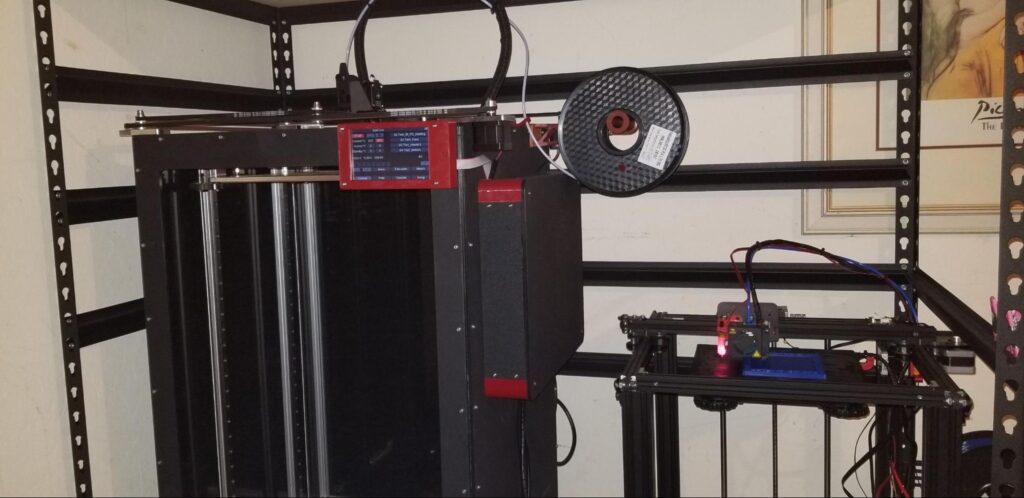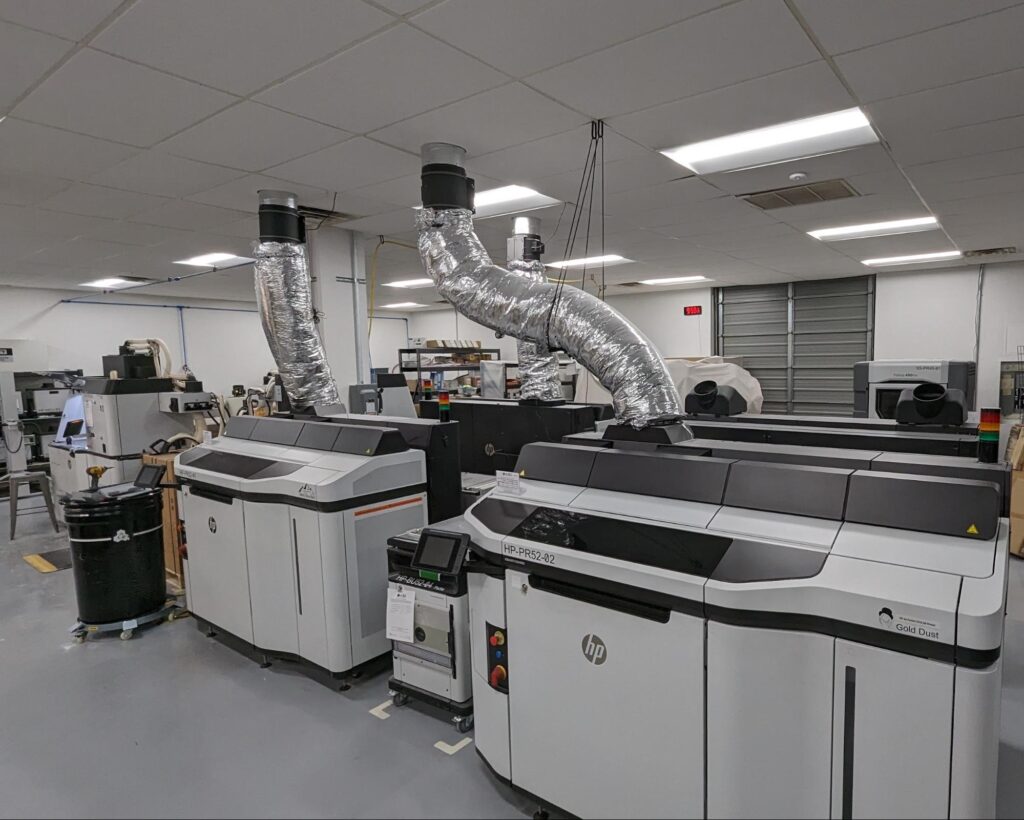The field of additive manufacturing (AM) has witnessed explosive growth and transformation in recent years, and 3D printing technicians have played a pivotal role in this journey. This article presents a comprehensive account of what it’s like to work in this position from the perspective of someone with over three years of hands-on experience with everything from consumer- to industrial-grade machines, such as those from Stratasys, Markforged, Formlabs, and HP.
Early Days in FDM/FFF Printing:
In my early days, I gained experience in my garage, where I only had four machines and sold just a couple hundred items. From that, I learned how to build an entire printer, thanks to the Railcore project. I also gained knowledge in how to work with various machine types and troubleshoot and repair issues relating to my equipment.
My first true professional experience began when I joined a company called MakeXYZ, where I began as a print technician and quickly rose to production manager. There, we had a lot of consumer-level printers ranging from Flashforge to the popular Prusa. I learned how to manage hundreds, if not thousands, of production parts and hundreds of orders every month. Moreover, I learned that I truly love being a print technician.
Daily Responsibilities at MakeXYZ
Every day, I would start my morning with a quick walk around the shop, in which I would check to see how all my overnight prints were progressing. This would include examining the filament supplies left on each roll, whether or not all parts were still printing, if shorter builds were complete, and finally, if there were any failures.
Even with machines as reliable as the Prusas, I would still encounter failures at least once a week. This is a relatively normal occurrence when you have over 30 machines running continuously.
From there, I would either begin repairs and troubleshooting the failures, or go check the print queue. The queue was made up of a backend page on the MakeXYZ site that showed all of the orders in process at that time. It also displayed customer parts, allowing me to chat with said clients about specific questions related to their components. It was a relatively simple process of post-processing the items, and then packaging and shipping.
A Change of Pace and Environment
For myriad reasons, MakeXYZ had to close its in-house operation and, after a year and a half, I had to say goodbye to a job that I loved. MakeXYZ is still fully operational, but no longer has an in-house operation. All the print jobs are out-sourced to various machine users who print the customer parts.
I soon found myself working for A3D Manufacturing and an environment that was a complete 180° from MakeXYZ. Not only was this a new workplace, it was completely different from a tech perspective. The company had the ISO 9001:2015 certification that held it to a much higher standard for its customers, as well as Markforged, Formlabs, Stratasys, and HP systems. I had never had the pleasure of working with such machines before, but I knew that was exactly what I wanted, and that I would work tirelessly to learn them and become the best technician possible.
Daily Responsibilities at A3D
The job itself was not all that different from MakeXYZ, as far as responsibilities go. I started every day by checking all the printers and making sure everything was successful or still printing properly. A main difference was that a failed print would happen once a month with these high-end machines. I would then take builds out of all the systems and then begin cleaning and prepping for the subsequent jobs.
Once the next set of prints had been uploaded and initiated, I could then post-process the parts. For items made with HP’s Multi Jet Fusion (MJF), the process requires unpacking and bead-blasting the parts to remove excess powder. Then, if the customer desires, dyeing the components. For Markforged and Stratasys’s Fused Deposition Modeling (FDM), the post-processing is the same as any other filament-based approach, removing supports and possibly sanding down any scars that may have been left behind. For Formlabs’s Stereolithography process, the components need to be washed and cleaned in isopropyl alcohol (IPA) and then cured before the supports are removed and the items sanded and polished. From there, no matter what the technology, the parts go to final quality control and shipping.
Challenges
One of the biggest challenges I have faced in this industry is the sheer quantity of parts. I have printed tens of thousands of components using all of the printing technologies mentioned. Unlike injection molding, thousands of items aren’t made at a time. They’re also not counted by a computer. Each and every part I’ve created has to be hand inspected. This allows me and the companies I work for to send out the highest quality components.
While there are significantly fewer print failures at my current job, these machines make up for increased reliability with increased complexity. It takes more time, and often specialized equipment to fix any one of these systems when they go down. In contrast, at my previous job, I was able to deploy off-the-shelf components and I could fix or rebuild about 10 printers a day.
Another challenge, which is actually my favorite part of being a print technician, is the adaptability that is required. You’re not working in an injection molding facility, repeatedly producing the same part all day, every day. There’s little time to optimize a component’s production, as there is only a limited quantity to make. The biggest lesson I’ve learned is that you have to bring your A game and be the most knowledgeable across a variety of part types and geometries.
Education
There is not much education that is formally required to be a print technician. I have a Certification in Drafting and Design and am pursuing a degree in Mechanical Drafting and Design. Though this degree requires that I take an AM class, I am testing out of it. My AM knowledge comes exclusively from being self-taught. I have purchased and built dozens of printers over the years. I was raised by an IT consultant and programmer, who has always had plenty of spare computers around to disassemble, and, with that, I have become a technical and logical thinker who likes to figure out how things work. Being a 3D print technician was well within my technical comfort zone. With that being said, here are some great classes that will help those interested in pursuing this career.
- A 3D printing/AM class: If a school nearby has a class dedicated to 3D printing, definitely take it. This is, perhaps, the fastest way to become familiar with the tools, software, and technology a print tech will encounter.
- Engineering classes: Having a technical mindset of how the mechanics of AM machines work is crucial. Engineering classes may not give you the specific skills to dismantle a 3D printer, but it will give you general insight into thinking mechanically.
- Programming: Programming is very helpful as all printers use software to convert 3D models into instructions for the machine to make a part. A knowledge of programming offers the unique advantage of giving you a deep understanding of how all the software works and what is happening within the printer’s “brain”.
- YouTube Certified: Without going to school, you can certainly buy your own 3D printer and embark on a journey of self-education. There are hundreds of YouTube creators out there who share information and create excellent learning platforms for any skill and experience level in the AM community.
Financial aspect
According to Salary.com and Zip Recruiter, the range for a print technician in the U.S. is between $22,000 and $56,000, with the median landing between $40,000 to $42,000. The salaries provided depend on location as well as the experience a technician has.
If you are interested in working as a 3D printing technician, you’ll likely enjoy the perk of occasionally printing your own parts. At both MakeXYZ and A3D, I’ve been allowed to produce my own items. While MakeXYZ allowed me to print whatever components I wanted as long as I provided the material and did not impede production, A3D offers me an employee discount.
As the world continues to evolve, so will 3D printing. According to Additive Manufacturing Research the 3D printing market is expected to grow compoundingly by an average of 13.98% between 2022 and 2030. This will undoubtedly create more jobs in the sector, as well as allow for increased salaries for those who have demonstrable skills and dedication to learn and adapt.
Deeper Dive
A 3D printing technician is a skilled professional responsible for operating and maintaining 3D printers. These workers play a vital role in the entire AM workflow, from the initial setup and calibration of the printer to monitoring the printing process and performing post-printing tasks. They possess a deep understanding of various AM technologies and materials, allowing them to select the most suitable options for specific projects. Additionally, 3D printing technicians troubleshoot any issues that may arise during printing and ensure the final products meet quality standards. Their expertise spans a range of industries, from aerospace and healthcare to automotive and consumer goods, where they contribute to the creation of prototypes, custom parts, and innovative products.
Conclusion
The life of a 3D printing technician, as I have experienced over the past three years, is a dynamic and rewarding journey filled with constant challenges that prompt learning and innovation. Working with various AM technologies has provided me with a well-rounded perspective on the diversity required within the field. As the technology continues to evolve, the role certainly remains crucial in driving innovation and shaping the future of manufacturing.
Subscribe to Our Email Newsletter
Stay up-to-date on all the latest news from the 3D printing industry and receive information and offers from third party vendors.
You May Also Like
New Report: Semiconductor Industry to See $1.4B in 3D Printing Revenues by 2032
“The semiconductor sector has become the most strategically significant area of global industry.” Truer words are hard to come by when it comes to the modern world, and they are...
Will Photonic-Crystal Lasers Revolutionize 3D Printing?
Powder bed fusion (PBF) for metals and polymers predominantly utilizes lasers as the primary heat source. Some directed energy deposition (DED) technologies also employ lasers, while various vat polymerization methods...
3D Printing Unpeeled: Orbex Investment, IndoMIM and HP, Ultrasonic Waves
INDO-MIM has bought three HP Metal Jet S100 printers, operating two in India and one in Texas. This is a win for HP because the company has deep experience in...
3D Printing Webinar and Event Roundup: April 21, 2024
It’s another busy week of webinars and events, starting with Hannover Messe in Germany and continuing with Metalcasting Congress, Chinaplas, TechBlick’s Innovation Festival, and more. Stratasys continues its advanced training...

































